The Bohemian’s Guide to Compact Cassette, or How To Get Into Cassette Tapes in 2023, Part One – Your First Player and Tapes
2023/08/10
Introduction
The year is 2023. Humanity has conquered the land, the seas, and
the skies. Highways and railways bring us closer together than ever
as they sprawl between bustling cities, while colossal ships and
sleek airplanes grant us dominion over realms we once only dreamed of
crossing. Slowly but surely, we are even venturing into the stars
above, bravely exploring new worlds beyond our own. Moreover, thanks
to radio, telephone, and the internet, we have created communities
spanning the entire world, bringing unprecedented social progress to
every corner of civilization (well, under ideal circumstances).
Finally, best of all, we have invented smartphones. It’s hard to
overstate just how damn useful those things are. Communication,
multimedia, computation, and entertainment that once needed entire
rooms’ worth of equipment can now fit into a convenient little
rectangle. I mean, who cares about the side effects? I’m
sure chronic isolation and constant overstimulation pose no
issues in day-to-day life.

In fact, with all these centuries of technological advancement culminating in the present day, you would be an absolute fool to ever revert to the technology of decades past. What kind of idiot still walks around with a cassette player when your run-of-the-mill smartphone can fit hundreds of times more music in random access digital format? I mean, who would go so far as to acquire a cassette deck and several dozen blank cassettes to record their digital music onto analog tape?
Well, fortunately for you, I am both a fool and an idiot, among a great variety of other things.
But Why?
For all the ways that smartphones have made our lives more convenient, they have also brought us more problems. As connected as we are to the internet in everything we do, being bombarded with information and media every hour of the day, our mental health inevitably declines. We have become permanently distracted, never bored yet never fulfilled, and through the invisible strings of media manipulation, we have grown bitter and hateful on the behalf of the rich and powerful.
Needless to say, we should spend less time on our phones. In place of the centralized utility that smartphones bring, it isn’t at all a bad idea to compartmentalize some of the things they do.
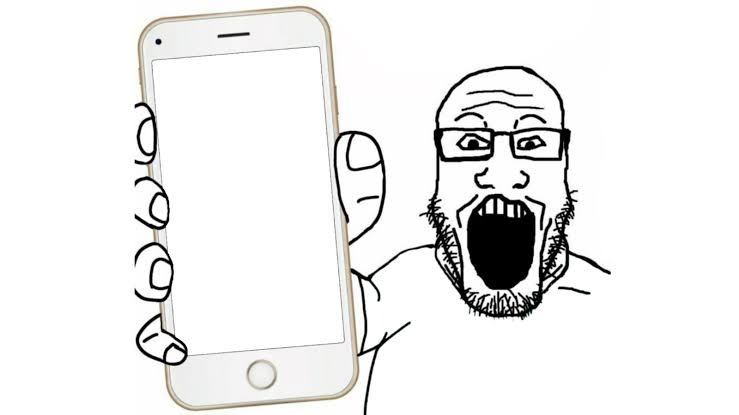
Thus, in place of digital music streaming, we can listen to cassette tapes.
Yeah, I know. The logic doesn’t really hold up. You could probably just get an MP3 player or something. But we’re not here to be reasonable. We’re here to listen to cassette tapes.
Anyways, when I first started getting into cassettes, I would really have liked a comprehensive guide on this niche-ass hobby. So here I am, a year or so in, making this guide for those also seeking to begin collecting and listening to this long-dead format.
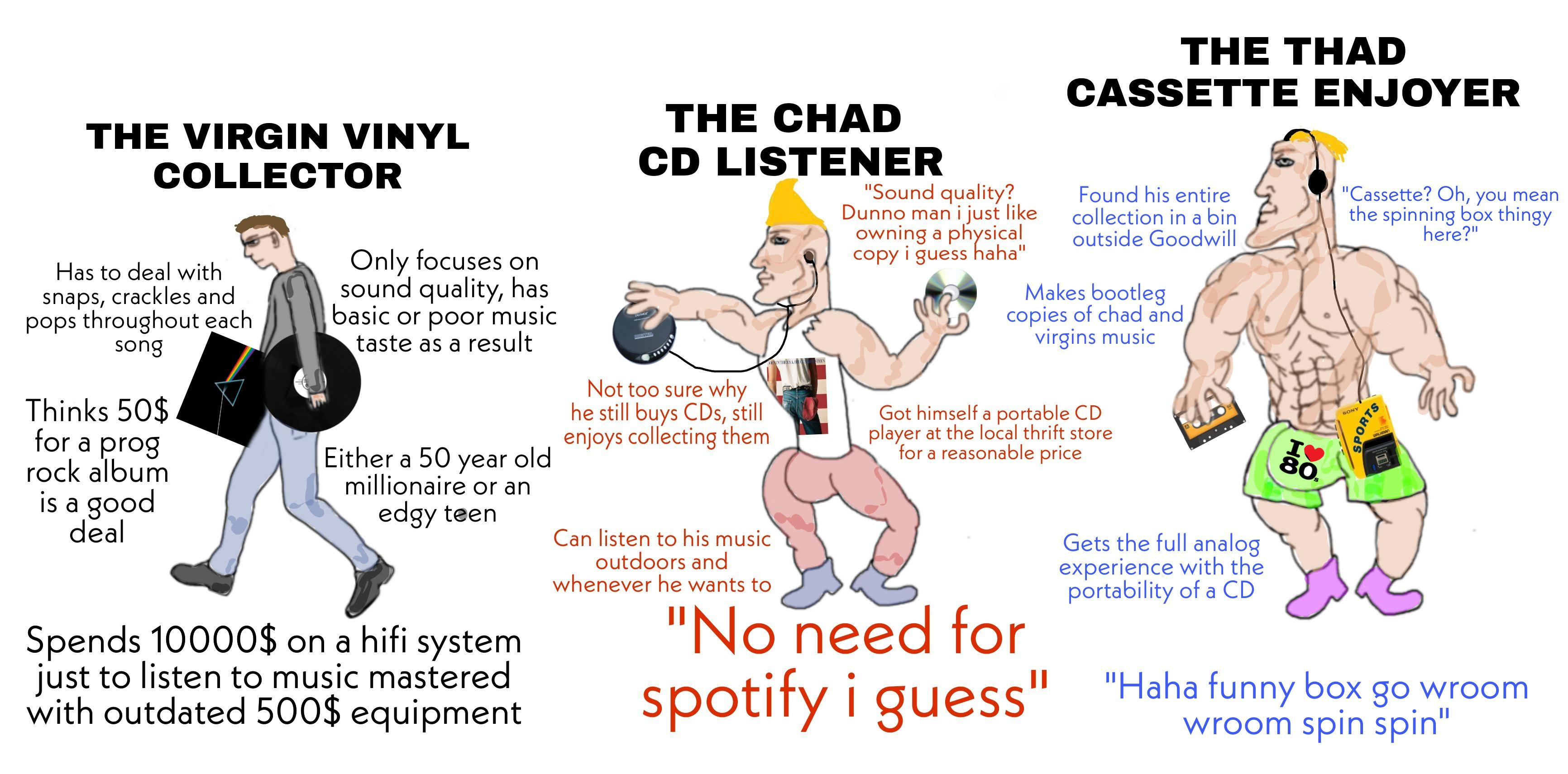
Your First Cassette Player
So, you’ve decided to dive into the world of compact cassette! Congratulations, you’re weird. Welcome to the club.
Time to find your first cassette player.
There are generally three types of players: portables, “shoebox” recorders, and decks. Portables are the ones that fit in your pocket or on your belt, and they usually only have the ability to play cassettes. Shoebox recorders (I’m not sure if that’s the official term) are the brick-sized ones that sit flat on office desks and are meant to record voice onto tapes. Finally, decks are the big ones—the dedicated home stereos components and the boomboxes, almost always with the ability to record onto tapes.

My portable cassette player collection. A couple are broken :(

My Phillips FW-900 mini hi-fi.

My trusty Akai HX-A351W deck, nestled nicely in my closet.
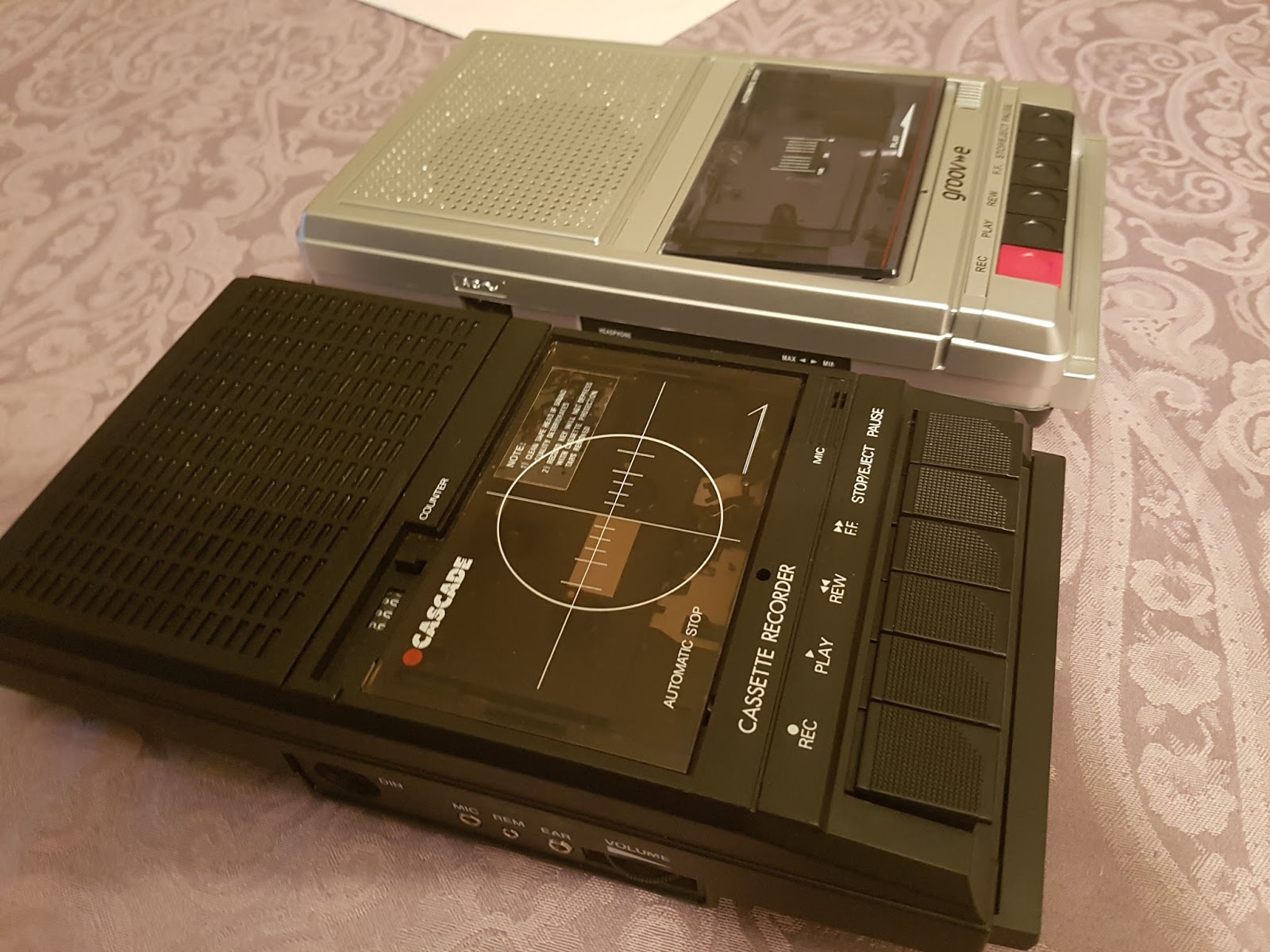
A couple of "shoebox" recorders. Credit
Portables are your best bet for starting. They let you experience cassette tapes without taking up too much space, and also let you listen on the go. Shoebox recorders on the other hand usually suck, unless you can find one that actually has a stereo read/write head instead of the usual mono mechanism. Besides, what niche they still fill in the modern day is mostly taken by the third category: decks. If you really want to get into cassettes, decks are a must-have, but I’ll cover them in the next post.
So, what portable player should you get?
Well, the best cassette player is the one you have, so if you get your hands on a working one previously owned by a family member or friend, you’re all set. But if you don’t, continue reading.
Now, you’ve probably seen them somewhere. Guardians of the Galaxy and Stranger Things drove up their prices far beyond retail on eBay, while the older among you might remember the variants which played CDs. Of course, I am talking about Walkmans. These are your quintessential cassette players, and they’re an excellent place to start. Provided they’re still functional after all these years, they can prove to be compact, reliable, and have excellent acoustic—
Wait, 800 dollars?
Yeah, they can get expensive. Let’s start over.

In 2023, cassette players are… well, they’re hard to come by. Of course, you can get one of those cheap new players on Amazon, and they do work, but they’re kind of awful, and you’re probably here in search of something good. Here’s the problem—no one really makes proper cassette players anymore. And why would they? Modern digital technology has entirely replaced analog compact cassette in a manner that is objectively, straight-up better in every conceivable way. There’s not a single dime to be made from manufacturing high quality cassette mechanisms.
Worse, many if not most surviving cassette players are broken. With the exception of the exceedingly rare Walkman DD (direct drive) series, every single cassette player, portable or deck, premium or budget, uses rubber belts in their mechanisms. Guess what rubber is made from? Petroleum. And guess what happens to rubber after a few decades? It decays back into petroleum. What were once precision drive mechanisms have almost all been reduced to sticky black messes—and no, they cannot play tapes in this state.
What is an aspiring compact cassette enthusiast to do about this?
Fortunately, there are a few common options.
The first and perhaps most accessible option, is to buy a newer used cassette player. Most players made between 1990 and 2010 are of decent quality while still new enough to have intact belts. Moreover, because they often bear the somewhat awkward (but nonetheless charming) design characteristics of 90s/2000s technology, they tend to be cheaper than more recognizable classic players. Some of these are Walkman branded—if you find a listing for one, they’re never a bad choice—but the rest can be just as good. Especially Panasonic. Never sleep on a good Panasonic cassette player.
The second option, for the more economically endowed among you, is to buy a refurbished cassette player. These have seen worse days, but through the work of a (hopefully) skilled seller, have been repaired and calibrated to be like new. Again, Walkmans are usually your best choice, but other brands can be just as good. Just be aware that refurbishment comes with a hefty service fee and usually isn’t budget-friendly.
The third option is to buy a broken or untested player and fix it yourself. This requires a lot of time and dedication, and also a good amount of experience. But if you wanna do it, go ahead. Indeed, this is what I do. It’s quite fun. Really, all you usually need is to clean the internal mechanism and replace the belts. There’s just a few things to keep in mind: go for the older (pre-y2k) players, because the newer ones tend to be very complex and require de-soldering to access their mechanisms. Though if you’re up to that, go ahead. Some players are also damaged in ways that can be very difficult or even outright impossible to repair (broken gears, busted capacitors, etc.), so you should contact the seller to know what’s wrong and decide if it’s actually worth the effort. There’s a lot more to consider when repairing cassette players, but I’ll cover that in a later post.
The Thrift Option
Okay, I lied. There’s four options. But although the fourth one is actually my favourite, it’s also an absolute wildcard.
Thrift stores can be amazing for finding old cassette players. But, of course, there’s no guarantee that they’ll actually work. You might get really lucky one day and nab a fully functional Walkman for thirty bucks, or you might only ever find rusted pieces of junk (like I have). And that’s assuming you even find a portable player in the first place—good condition or not, they’re usually very rare. Overall, you’ll probably find yourself having to repair or at least calibrate whatever player you end up thrifting. It helps to bring batteries to test them, but again, buying cassette players this way a wildcard. I’ll delve more into thrifting and salvaging/dumpster diving cassette players in a later blog post.

Playing Tapes
Alright. You’ve got a cassette player. Now what?
Now, it’s time to play some tapes.
At first, you may find your listening options to be quite limited. There are a few ways to get tapes, but you probably won’t find any newer music unless you specifically look for new cassette releases. And yes, some contemporary artists do actually release music on cassette.
In no particular order, you’ll typically find yourself with three options.
1.) Ask around.
Chances are, you’ll likely have family members or friends with old cassette tapes lying around their houses. Hit them up sometime, then when they’re not looking, raid their basement for tapes. You’re sure to find some good classic albums. (Of course I’m joking. Ask nicely, as they might still treasure their old music collections.)
2.) Visit a thrift store.
Any thrift store of decent size will certainly have an old media section—and that includes cassette tapes. Since demand for compact cassette is quite low compared to CDs and vinyl records, you’ll probably find some good stuff.
3.) Buy albums online.
If you’re looking for a specific tape and you can’t find it anywhere else, people sell tapes online for generally reasonable prices. If you find yourself rather empty-handed after exploring the previous two options, this one definitely isn’t bad. However, buying tapes online will be more expensive than finding or thrifting tapes.
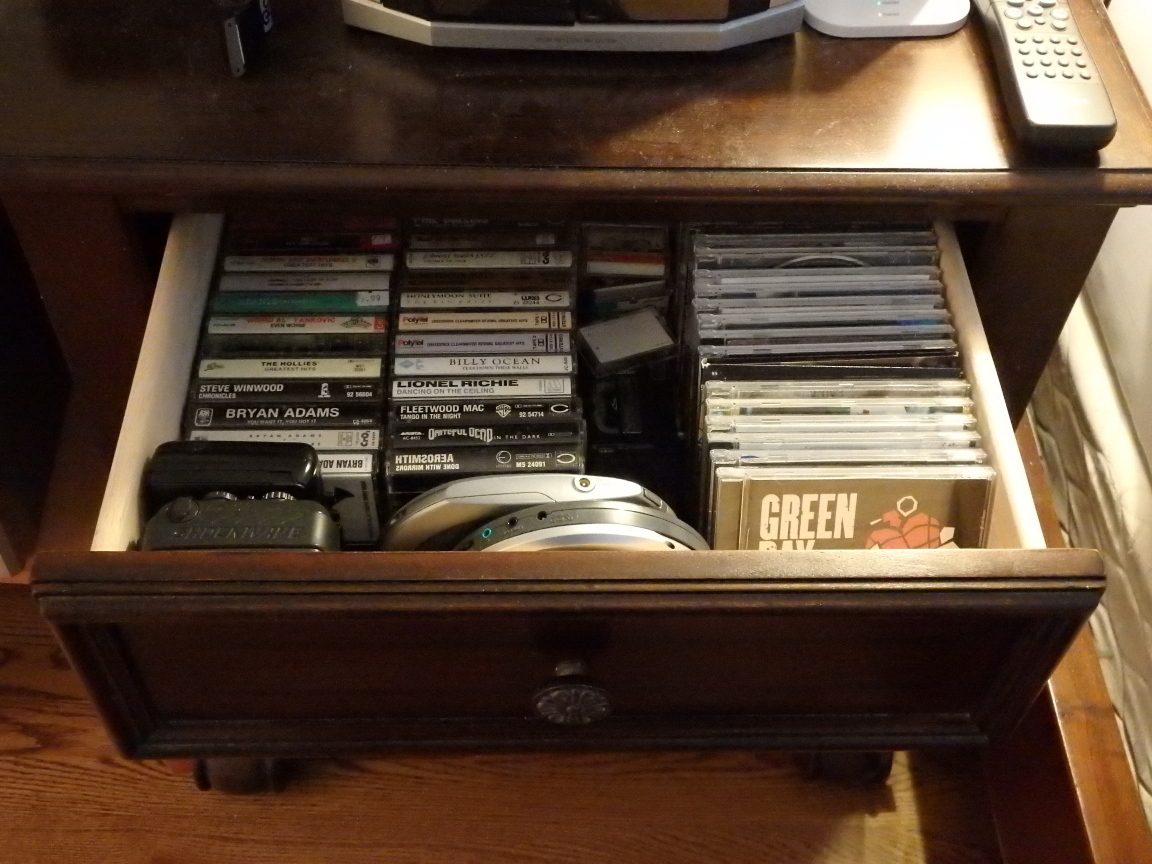
Part of my tape collection.
Cool! You have tapes and a player now. Now what?
Now, plug some headphones into your player, stick a tape inside, and press “play.” This will engage the tape mechanism, lifting a magnetic read head to the tape, lifting a rubber pinch roller to pinch the tape against a thin metal capstan, and powering on the player’s motor to advance the tape at around 4.76 centimetres per second. To stop your music, press “stop,” and to navigate forward and backward, press “fast forward” or “rewind.” Some players may also have a “pause” button, which stops the motor rather than disengaging the entire mechanism. Sorry, no skipping tracks here—this is an analog sequential access format.

My Walkman WM-SXF10 with its lid unlatched.

Note the controls. From left to right: stop, play, rewind, fast forward.
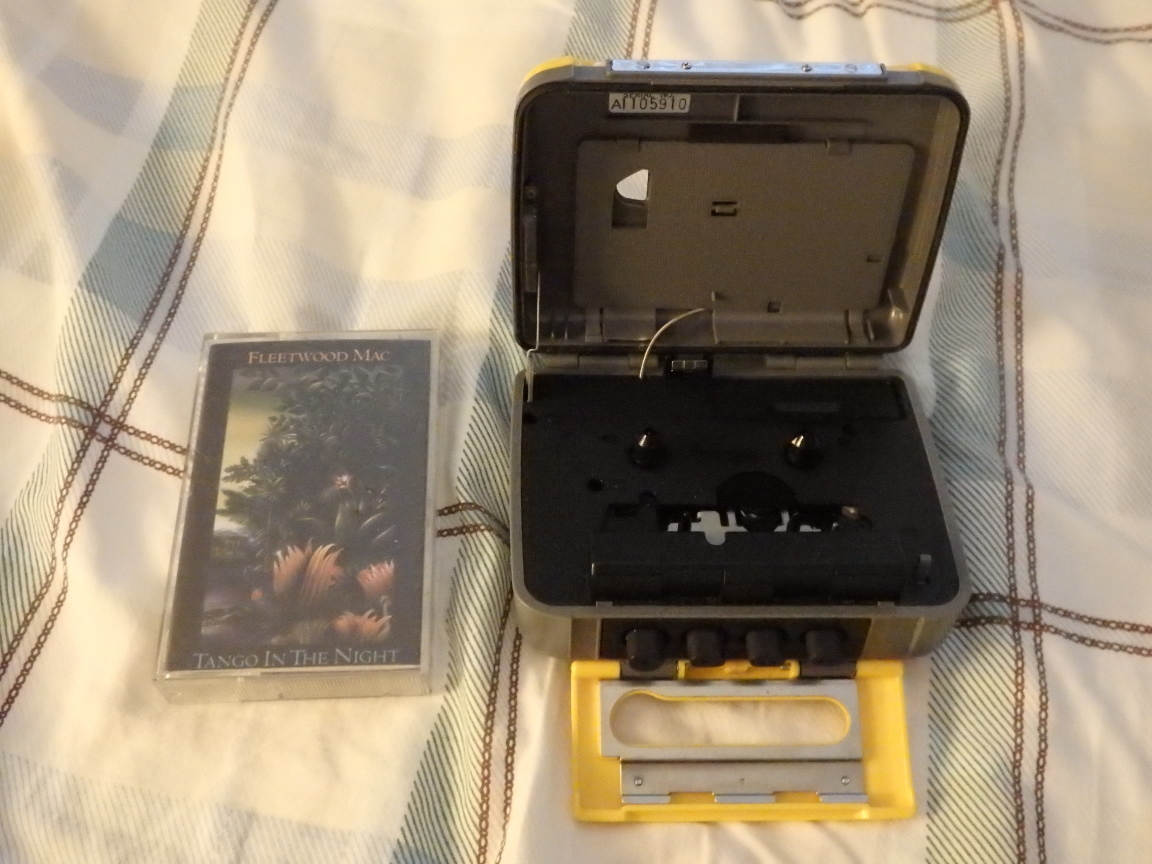
The inside of the Walkman, prepared to play a banger-ass Fleetwood Mac tape. Note the two hubs sticking out where the holes of the tape will go.
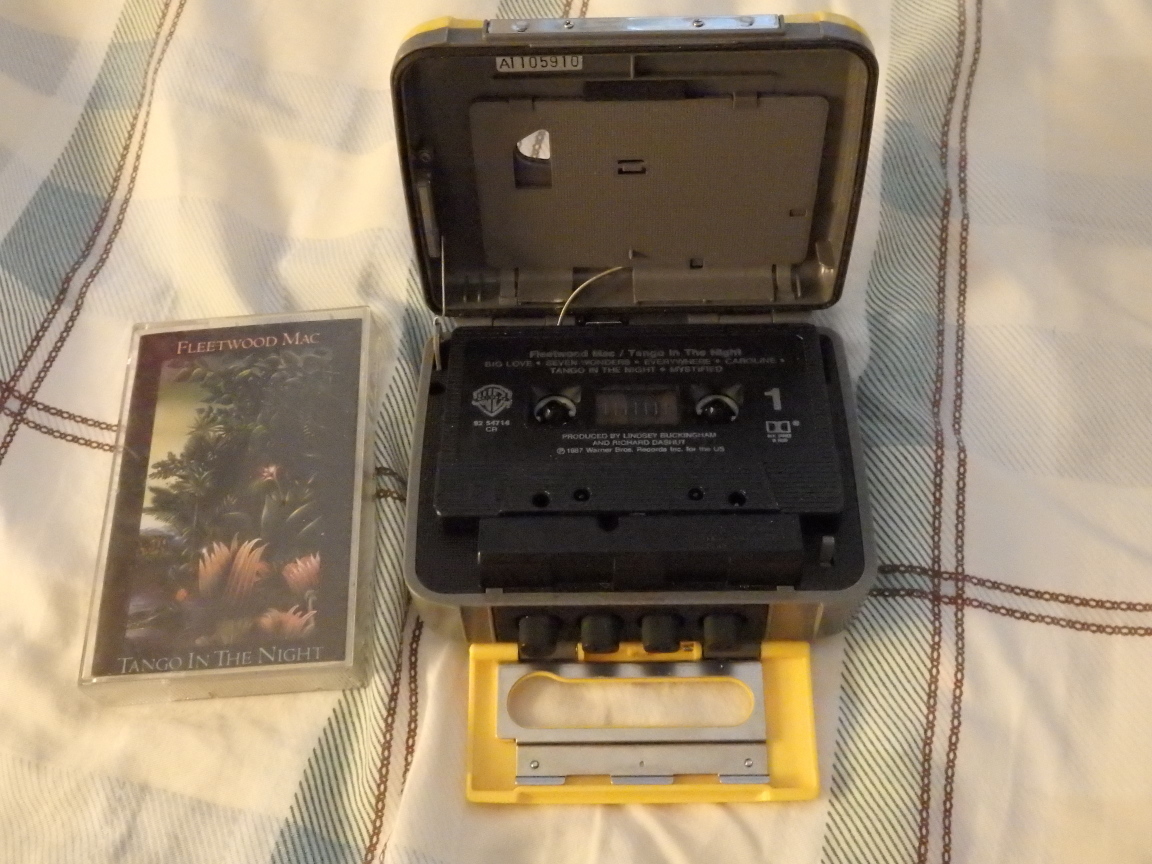
The banger-ass Fleetwood Mac tape in question, now slotted neatly into the Walkman.

Banger-ass Fleetwood Mac tape inside, with the "play" button pressed down. Note the engaged read head at the centre, as well as the rubber pinch roller rising to snugly meet the thin metal capstan.
There. You are now experiencing the magic of compact cassette, a revolutionary magnetic audio format! For the time, at least. Instead of listening to people tell you that you’re wasting your time with obsolete media, your ears will be filled with mediocre fidelity music from decades past. Screw them; life’s too short, and we might as well do some dumb shit before succumbing to the ravages of entropy.
Really though, enjoy this wonderfully anachronistic way of listening to music! There’s nothing quite like the charm of a spinning cassette or the quality of tape running along a read head.
…Except… what if I told you we don’t have to be stuck with listening to old music on tape? I’m not just talking about those new cassette releases that some bands and artists sell (shoutout to Red Hot Chili Peppers). There is so much more to compact cassette than Walkmans and old albums. What if you want to make bootlegs? Mixtapes? Or even voice journals? What if you want to use this old format to make new music? Stay tuned, because next time I’ll be covering the ins and outs of tape recording…
Peace out besties! :3
